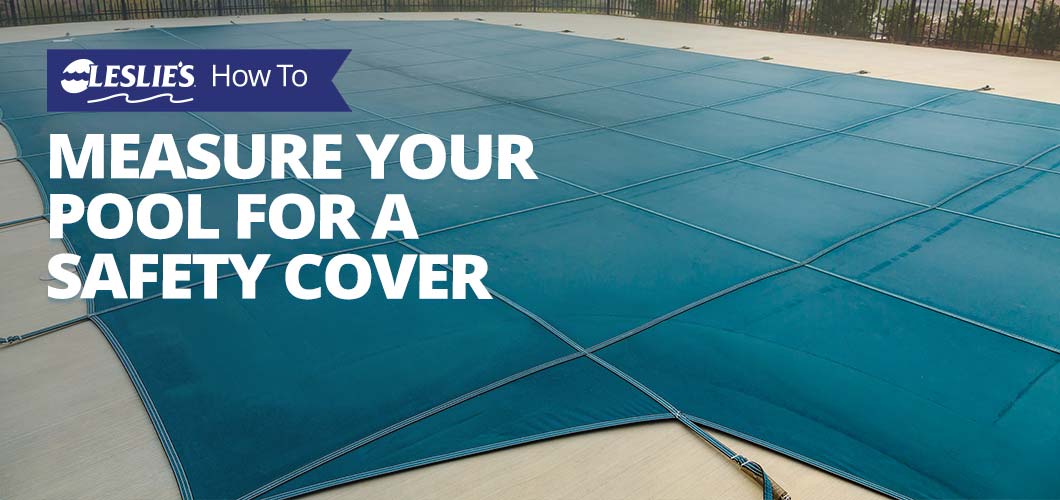
How to Measure Your Pool for a Safety Cover
When the swimming season comes to an end, it's important to protect your pool from the winter elements. Although a basic pool cover will do the job, it won't provide extra protection for your loved ones. A safety cover, however, will significantly reduce the risk of pool-related injuries through the off-season. But how do you measure your pool for a safety cover?
Why Safety Pool Covers?
Unlike a winter cover, which is only held in place by moveable water bags, a safety cover is anchored securely to the deck. Because of this, a safety cover eliminates the risk of falling in the pool, giving you peace of mind if children or animals happen to step on the cover or run across it.
What are the Options for Safety Pool Covers?
We carry five types of safety pool covers to choose from: Original Mesh, Pro Solid, Pro Supreme Solid, Pro Sunblocker Mesh, and Pro 30–Year Commercial Mesh. You can read about the differences between each type on our safety pool covers page. We also suggest looking at our Safety Cover Buyer's Guide to figure out which type — solid or mesh — is right for you. If you have a standard rectangular-shaped pool or a left/right/center end step section, there are a few measuring tips in the buyer's guide that will help you choose the correct size. However, if you're needing a custom cover for a unique size or shape of pool, keep reading to learn how to measure for a custom safety cover.
Before You Begin Measuring for a Safety Cover...
Before you begin, download the Leslie’s custom safety cover form. This PDF will help you along the way in the measuring process. Now, let’s take a look at how to properly measure your pool for a safety cover.
It's important to take your time and measure correctly. Remember, the manufacturer producing your cover will only have the measurements you provide when making your cover. Accuracy is of the utmost importance!
Time to Measure the Pool
Measurements are fairly straightforward for rectangular pools or pools with a 4'x8' end step section. However, for unique pools and features, we use the A-B triangulation measuring method.
This method of measuring for a safety cover uses triangulation to determine the shape of the cover with all the pool's features. We recommend marking points at 3-foot intervals around the pool perimeter for this version of measurement. Also place markings where there are obstructions, such as handrails, slide legs, diving platforms, and so forth. We recommend using chalk or painter's tape when marking points on the pool.
In addition to the markers around the perimeter, you'll also need to set two stakes in the ground as anchor points for measurement reference. You'll measure the distance between the A and B anchor points, and the distance between those points and the numbered perimeter markers.
Finally, you should provide a sketch of the pool with the A-B lines, cross-dimensions, and notes concerning special features or obstructions, similar to what's shown here:

Things to Keep in Mind When Measuring
Although this seems simple enough, it's easy to get wrong. For instance, the stakes you put into the ground might pull out of position during the measuring process. Another common error is to take measurement points around the pool in the wrong direction. The manufacturer is expecting the measurements to be clockwise (from left to right). If you take measurements counter-clockwise (from right to left), you'll end up with a mirror image of the pool.
A lot of manufacturers recommend that, in addition to the sketch and measurements for your safety cover, you should provide pictures of the pool. Take close-up photos of any raised walls, ladders, handrails, and any other unique features. Also take a photo that shows a wide view of the entire pool. This gives the manufacturer an idea of any details that might have been accidentally left out on the measuring form.
It can also be helpful to the cover manufacturer if you measure the perimeter of any special features. Measure around the spas and other features, and provide these measurements, as well. This will help ensure your cover is made correctly.
Inching Toward Success
There you have it! Although this can be a time-consuming and somewhat painstaking task, measuring your pool correctly is the only way to confidently order a custom safety cover. With accurate measurements, you will have security, protection, and — most importantly — properly fitted cover for your pool!
If you have any other questions about safety covers or the measurement process, call or stop by your local Leslie's. We're happy to help!